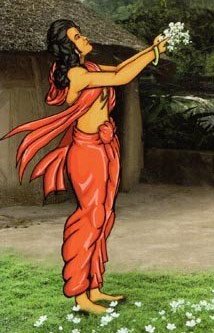Prabhasakshetra, Prabhasa-kshetra, Prabhāsakṣetra: 2 definitions
Introduction:
Prabhasakshetra means something in Hinduism, Sanskrit. If you want to know the exact meaning, history, etymology or English translation of this term then check out the descriptions on this page. Add your comment or reference to a book if you want to contribute to this summary article.
The Sanskrit term Prabhāsakṣetra can be transliterated into English as Prabhasaksetra or Prabhasakshetra, using the IAST transliteration scheme (?).
In Hinduism
Kavya (poetry)
Source: Shodhganga: A critical appreciation of soddhalas udayasundarikathaPrabhāsakṣetra (प्रभासक्षेत्र).—Soḍḍhala has referred to Prabhāsa-kṣetra, on the coast of Kathiawar, where the shrine of Śrī Somanātha had been already established. People worshiped Somanātha for the fulfilment of their desired object.

Kavya (काव्य, kavya) refers to Sanskrit poetry, a popular ancient Indian tradition of literature. There have been many Sanskrit poets over the ages, hailing from ancient India and beyond. This topic includes mahakavya, or ‘epic poetry’ and natya, or ‘dramatic poetry’.
Languages of India and abroad
Sanskrit dictionary
Source: Cologne Digital Sanskrit Dictionaries: Monier-Williams Sanskrit-English DictionaryPrabhāsakṣetra (प्रभासक्षेत्र):—[=pra-bhāsa-kṣetra] [from pra-bhāsa > pra-bhās] n.
Sanskrit, also spelled संस्कृतम् (saṃskṛtam), is an ancient language of India commonly seen as the grandmother of the Indo-European language family (even English!). Closely allied with Prakrit and Pali, Sanskrit is more exhaustive in both grammar and terms and has the most extensive collection of literature in the world, greatly surpassing its sister-languages Greek and Latin.
See also (Relevant definitions)
Partial matches: Kshetra, Prabhasa.
Starts with: Prabhasakshetramahatmya, Prabhasakshetratirtha, Prabhasakshetratirthayatranukrama.
Full-text: Prabhasika, Saurashtra, Surashtram, Somanatha, Raivataka, Durmukha.
Relevant text
Search found 5 books and stories containing Prabhasakshetra, Prabhasa-kshetra, Prabhāsakṣetra, Prabhāsa-kṣetra, Prabhasaksetra, Prabhasa-ksetra; (plurals include: Prabhasakshetras, kshetras, Prabhāsakṣetras, kṣetras, Prabhasaksetras, ksetras). You can also click to the full overview containing English textual excerpts. Below are direct links for the most relevant articles:
Garga Samhita (English) (by Danavir Goswami)
Verse 5.9.15 < [Chapter 9 - The Happiness of the Yadus]
The Skanda Purana (by G. V. Tagare)
Chapter 9 - The Garland of Skulls and Tattvas < [Section 1 - Prabhāsa-kṣetra-māhātmya]
Section 1 - Prabhāsa-kṣetra-māhātmya < [Book 7 - Prabhāsa Khaṇḍa]
Chapter 14 - Creation of Siddheśvara (Siddha-īśvara) < [Section 1 - Prabhāsa-kṣetra-māhātmya]
Chaitanya Bhagavata (by Bhumipati Dāsa)
Verse 1.9.121 < [Chapter 9 - Nityānanda’s Childhood Pastimes and Travels to Holy Places]
Verse 1.8.26 < [Chapter 8 - The Disappearance of Jagannātha Miśra]
Vedic influence on the Sun-worship in the Puranas (by Goswami Mitali)
Part 10 - Temples and Pilgrimages for Worshipping the Sun-god in the Purāṇas < [Chapter 4 - Vedic Influence on the Sun-Worship in the Purāṇas]